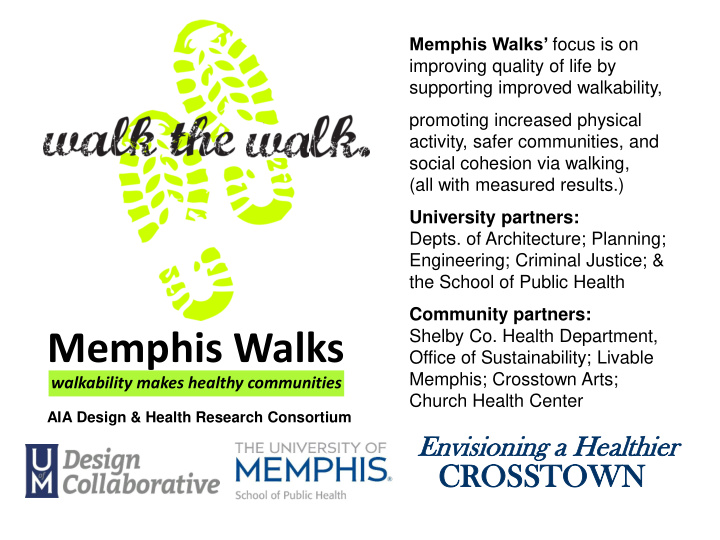



Memphis Walks’ focus is on improving quality of life by supporting improved walkability, promoting increased physical activity, safer communities, and social cohesion via walking, (all with measured results.) University partners: Depts. of Architecture; Planning; Engineering; Criminal Justice; & the School of Public Health Community partners: Memphis Walks Shelby Co. Health Department, Office of Sustainability; Livable Memphis; Crosstown Arts; walkability makes healthy communities Church Health Center AIA Design & Health Research Consortium Env nvis isionin ioning g a a Heal althi thier CRO ROSSTOWN TOWN
The Need: Memphis Pedestrian Fatalities: ranks #5 most dangerous large metro area Community/Environmental Indicators: ranks #47 (ACSM) Crime: ranks #3 (FBI) Personal Health: ranks #49 (ACSM Fitness Index) 35% obesity (BRFSS) 37% hypertension (BRFSS) 13% diabetes; 6.6% pre-diabetes (BRFSS) 28% physical inactivity (BRFSS)
Objective Address walkability issues of urban communities in order to promote improved physical health Why is Walkability Important?
Crosstown Neighborhood
Neighborhood Perception Survey
Neighborhood Perception Survey
Progress to date • University and Community Partner roles • Weekly team/community meetings • Stakeholder input • Survey development • Student orientation
Next xt Steps • University Institution Review Board (IRB) approval • Community Perceptions Survey: (walkability, crime, safety, blight, traffic, social engagement, and health status) • Environmental Assessments: (demographics, crime statistics, lighting, pedestrian assessments, traffic issues, pedestrian counts, land use, and physical conditions) • Data Analysis; Report outcomes to community • Healthy Communities Summit on May 4, 2016
Recommend
More recommend